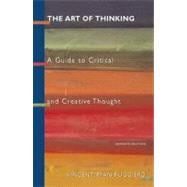
| Each chapter concludes with ôWarm-Up Excercises,ö ôApplications,ö and ôComposition or Speech Excercise.ö | |
| To the Instructor | |
| Be Aware | |
| Developing Your Thinking: An Overview | |
| What Is Thinking? | |
| The Importance of Thinking | |
| Brain and Mind at Work | |
| The Production Phase | |
| The Judgment Phase | |
| Good Thinking Is a Habit | |
| The Structure of This Book | |
| Getting the Most from Your Efforts | |
| Using Feelings to Advantage | |
| Learning to Concentrate | |
| Coping with Frustration | |
| Making Discussion Meaningful | |
| Preliminary Thinking Strategies | |
| Sample Exercises and Responses | |
| Establish a Foundation | |
| Free Will versus Determinism | |
| What Is Truth? | |
| What Is Knowing? | |
| Ways of Knowing | |
| Experience | |
| Observation | |
| Report | |
| The Problem of Remembering | |
| What Are Opinions? | |
| Expressions of Taste | |
| Expressions of Judgment | |
| Debating Moral Questions | |
| The Basis of Moral Judgment | |
| Dealing with Dilemmas | |
| Broaden Your Perspective | |
| Becoming an Individual | |
| Habits That Hinder Thinking | |
| The Mine-Is-Better Habit | |
| Face Saving | |
| Resistance to Change | |
| Conformity | |
| Stereotyping | |
| Self-Deception | |
| Overcoming Bad Habits | |
| Be a Critical Reader | |
| Critical Reading Defined | |
| Making Important Distinctions | |
| The Distinction Between the Person and the Idea | |
| The Distinction Between Matters of Taste and Matters of Judgment | |
| The Distinction Between Fact and Interpretation | |
| The Distinction Between Literal and Ironic Statements | |
| The Distinction Between an Idea's Validity and the Quality of Its Expression | |
| The Distinction Between Language and Reality | |
| A Strategy for Critical Reading | |
| Step 1: Skim | |
| Step 2: Reflect | |
| Step 3: Read | |
| Step 4: Evaluate | |
| Expressing Your Judgment | |
| A Sample Evaluation | |
| Be Creative | |
| The Creative Process | |
| Key Facts About Creativity | |
| Characteristics of Creative People | |
| Applying Creativity to Problems and Issues | |
| Taking a Novel Approach | |
| Devising or Modifying a Process or System | |
| Inventing a New Product or Service | |
| Finding New Uses for Existing Things | |
| Improving Things | |
| Inventing or Redefining a Concept | |
| Stages in the Creative Process | |
| The First Stage: Searching for Challenges | |
| The Second Stage: Expressing the Problem or Issue | |
| The Third Stage: Investigating the Problem or Issue | |
| The Fourth Stage: Producing Ideas | |
| Search for Challenges | |
| The Importance of Curiosity | |
| How Curiosity Is Lost | |
| Regaining Your Curiosity | |
| Six Helpful Techniques | |
| Be Observant | |
| Look for Imperfections | |
| Note Your Own and Others' Dissatisfactions | |
| Search for Causes | |
| Be Sensitive to Implications | |
| Recognize the Opportunity in Controversy | |
| Express the Problem or Issue | |
| Distinguishing Problems from Issues | |
| Expressing Problems | |
| Expressing Issues | |
| When Problems Become Issues | |
| Guidelines for Expressing Problems and Issues | |
| Benefits of Careful Expression | |
| It Helps You Move Beyond the Familiar and Habitual | |
| It Keeps Your Thinking Flexible | |
| It Opens Many Lines of Thought | |
| A Sample Problem | |
| A Sample Issue | |
| Investigate the Problem or Issue | |
| What to Look for | |
| Eyewit | |
| Table of Contents provided by Publisher. All Rights Reserved. |
The New copy of this book will include any supplemental materials advertised. Please check the title of the book to determine if it should include any access cards, study guides, lab manuals, CDs, etc.
The Used, Rental and eBook copies of this book are not guaranteed to include any supplemental materials. Typically, only the book itself is included. This is true even if the title states it includes any access cards, study guides, lab manuals, CDs, etc.